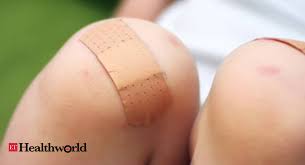- Home
- Editorial
- News
- Practice Guidelines
- Anesthesiology Guidelines
- Cancer Guidelines
- Cardiac Sciences Guidelines
- Critical Care Guidelines
- Dentistry Guidelines
- Dermatology Guidelines
- Diabetes and Endo Guidelines
- Diagnostics Guidelines
- ENT Guidelines
- Featured Practice Guidelines
- Gastroenterology Guidelines
- Geriatrics Guidelines
- Medicine Guidelines
- Nephrology Guidelines
- Neurosciences Guidelines
- Obs and Gynae Guidelines
- Ophthalmology Guidelines
- Orthopaedics Guidelines
- Paediatrics Guidelines
- Psychiatry Guidelines
- Pulmonology Guidelines
- Radiology Guidelines
- Surgery Guidelines
- Urology Guidelines
Self-powered e-bandage speeds wound healing

Doctors have tried various approaches to help chronic wounds heal, including bandaging, dressing, exposure to oxygen and growth-factor therapy, but they often show limited effectiveness.
Washington: Scientists have developed a self-powered bandage that generates an electric field over an injury, dramatically reducing the healing time for skin wounds. Skin has a remarkable ability to heal itself, but in some cases, wounds heal very slowly or not at all, putting a person at risk for chronic pain, infection and scarring.
Chronic skin wounds include diabetic foot ulcers, venous ulcers and non-healing surgical wounds.
Doctors have tried various approaches to help chronic wounds heal, including bandaging, dressing, exposure to oxygen and growth-factor therapy, but they often show limited effectiveness.
Researchers from University of Wisconsin in the US and University of Electronic Science and Technology of China wanted to develop a flexible, self-powered bandage that could convert skin movements into a therapeutic electric field. They tested the bandage on rats.
To power their e-bandage, the team made a wearable nanogenerator by overlapping sheets of polytetrafluoroethylene (PTFE), copper foil and polyethylene terephthalate (PET).
The nanogenerator converted skin movements, which occur during normal activity or even breathing, into small electrical pulses.
This current flowed to two working electrodes that were placed on either side of the skin wound to produce a weak electric field. The team tested the device by placing it over wounds on rats' backs.
Wounds covered by e-bandages closed within three days, compared with 12 days for a control bandage with no electric field. The researchers attribute the faster wound healing to enhanced fibroblast migration, proliferation and differentiation induced by the electric field.

Disclaimer: This site is primarily intended for healthcare professionals. Any content/information on this website does not replace the advice of medical and/or health professionals and should not be construed as medical/diagnostic advice/endorsement or prescription. Use of this site is subject to our terms of use, privacy policy, advertisement policy. © 2020 Minerva Medical Treatment Pvt Ltd